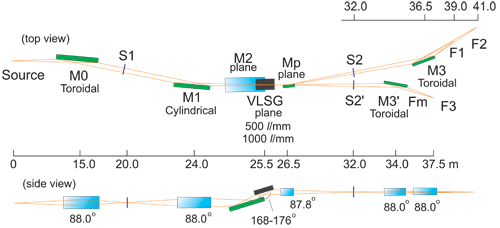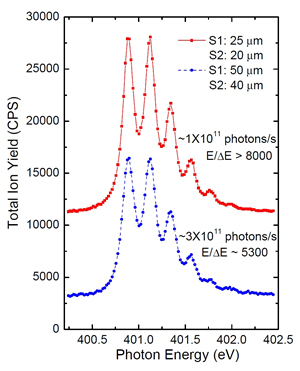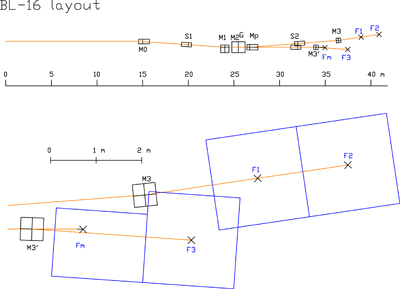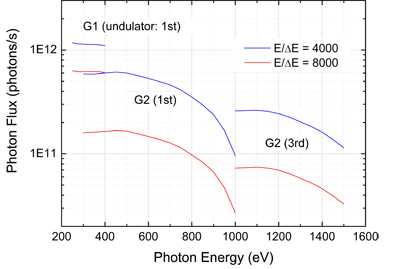BL-16A: Variable Polarization Soft X-ray spectroscopy Station
Spokesperson: Kenta
AMEMIYA
6027(PHS4729)
kenta.amemiya@kek.jp
@
1. Outline
The soft X-ray beamline, BL-16A, provides circular and elliptical polarizations, as well as horizontal and vertical linear polarizations, by adopting APPLE-II type undulators and a variable-included-angle varied-line-spacing plane-grating monochromator [1]. One can apply the X-ray magnetic circular dichroism (XMCD), magnetic linear dichroism (XMLD) and X-ray resonant scattering (XRS) techniques in order to mainly investigate magnetic thin films. In addition, a real-time observation of surface chemical reaction is possible by using a wavelength-dispersive X-ray absorption spectroscopy (XAS), without the pump-and-probe technique [2].
Recently, a polarization switching between the circular polarizations, as well as the horizontal and vertical linear polarizations, has been achieved by using twin APPLE-II type undulators [3]. It is expected that the signal-to-noise ratio in the XMCD and XMLD measurements is significantly improved. In addition, a real-time observation of molecular orientation is also possible by combining polarization switching between horizontal and vertical polarizations with the wavelength-dispersive XAS [4].
Figure 1 shows schematic layout of the beamline optics. The beamtime is assigned for users by using three experimental ports, F1, F2, and F3 to efficiently utilize the beamtime.

Fig. 1. Schematic layout for BL-16A.
2. Performance
The available energy region depends on the polarization as listed below :
Circular polarizations: 297 - 1000 eV,
Horizontal linear polarization: 180 - 1500 eV,
Vertical linear polarization: 380 - 1500 eV,
Elliptical polarizations: 218 - 1500 eV.
One can change the undulator parameters including the polarizations at any time. A typical performance of the beamline is given in Figs. 2 and 3. A typical beam size at the experimental ports is ~0.1-0.2 and ~0.2-0.5 mm in the vertical and horizontal directions, respectively.
|
Fig. 2. Expected photon flux at fixed resolving powers, E/¢E. |
 |
| Fig. 3. Estimation of typical photon flux and resolving power by N K-edge spectrum. |
3. Experimental
apparatus
Figure 4 shows the alignment of the
experimental stations. A superconducting-magnet XMCD apparatus is
fixed at F2, while the wavelength-dispersive XAS measurement is
carried out at F1. F3 is the gfree porth at which some apparatus are
interchangeably placed.

Fig. 4. Geometrical layout of the experimental stations.
[List of
experimental apparatus opened for users]
1.
Superconducting-magnet XMCD apparatus
Magnetic field: up to 5
T, lowest sample temperature: 30 K, total electron yield (drain current)
and fluorescence yield measurements (using a Silicon Drift Detector) are
available.
2. Normal conducting-magnet XMCD apparatus
Magnetic field: up to 1.2 T, lowest sample temperature: 30 K, total
electron yield (drain current) and total fluorescence yield (MCP)
measurements are available.
3. Depth-resolved XMCD
apparatus [5,6]
A depth-resolved XMCD measurement with an
atomic-layer resolution is possible by using the detection-angle
dependence of the probing depth of the electron-yield spectra. Magnetic
field: up to 0.05 - 0.1 T (only before each measurement), lowest sample
temperature: 100 K, total electron yield (drain current) measurement is
also available.
4.
References
[1] K.Amemiya et al., "Commissioning of a
Soft X-ray Beamline PF-BL-16A with a Variable-Included-Angle
Varied-Line-Spacing Grating Monochromator", AIP Conf. Proc. 1234 (2010)
295.
[2] K.Amemiya et al., "Real-time observation of CO
oxidation reaction on Ir(111) surface at 33 ms resolution by
means of wavelength-dispersive near-edge x-ray absorption fine structure
spectroscopy", Appl. Phys. Lett. 99 (2011) 074104.
[3]
K.Amemiya et al., "Fast polarization switching in the soft X-ray region at
PF BL-16A", J. Phy.: Conf. Ser., in press.
[4] K.Amemiya et
al, "Molecular orientation change during adsorption of NO and
N2O on Ir(111) observed by real-time
wavelength-dispersive x-ray absorption spectroscopy with polarization
switching", Appl. Phys. Lett., submitted.
[5] K. Amemiya et
al., "Direct observation of magnetic depth profiles of thin Fe films on
Cu(100) and Ni/Cu(100) with the depth-resolved x-ray magnetic
circular dichroism", Appl. Phys. Lett. 84 (2004) 936.
[6]
K. Amemiya, "Sub-nm Resolution Depth Profiling of the Chemical state and
Magnetic Structure of Thin Films by the Depth-Resolved X-ray
Absorption Spectroscopy Technique", Phys. Chem. Chem. Phys. 14 (2012)
10477.
15/03/27
![]()
